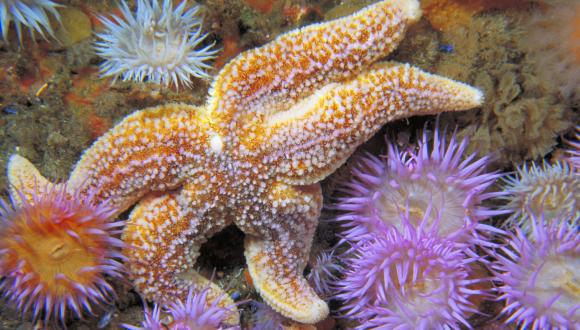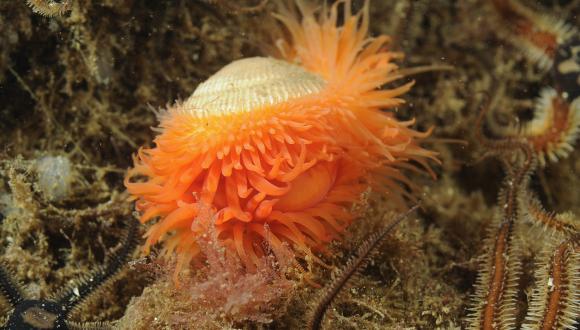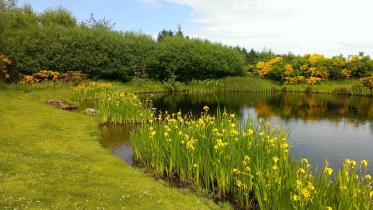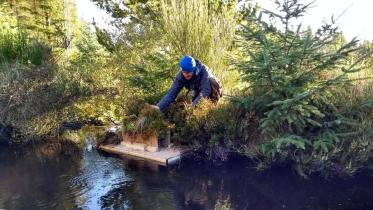Nature Restoration Fund - Priorities for Action

About the Nature Restoration Fund
The strategic goal of the Nature Restoration Fund (NRF) is to catalyse action at scale to protect and restore Scotland’s biodiversity on land and sea.
The draft Scottish Biodiversity Strategy defines clear priorities for the NRF and the impact we want projects to deliver. The NRF currently focuses on broad priority themes, which will be further refined on publication of the Scottish Biodiversity Strategy later in 2023.
We are particularly keen to encourage and support partnership projects. These will be required to make the transformational changes needed to restore nature at the required scale and pace to achieve our biodiversity targets across our land, freshwater and seas by 2045.
IPBES direct drivers of biodiversity loss
The scale of the challenges facing us were highlighted in May 2019 when the Intergovernmental Science-Policy Platform on Biodiversity and Ecosystem Services (IPBES) described the prevalence of five direct drivers that are causing the loss of biodiversity and substantially reducing what nature can provide for people. This makes it clear that action for nature that tackles these drivers and the indirect drivers which cause them are a priority that cannot wait.
The IPBES direct drivers of biodiversity loss are:
- Land and sea-use change
- Direct exploitation of organisms
- Climate change and its impacts
- Pollution
- Invasive non-native species (INNS)
The priority themes help to tackle these drivers:
- Habitat and species restoration: Management for enhancement and connectivity.
- Freshwater restoration, including restoration of natural flows in rural catchments
- Coastal and marine initiatives which promote restoration, recovery, enhancement or resilience
- Control of invasive non-native species (INNS) impacting on nature
- Urban: Enhancing and connecting nature across, and between, towns and cities.
Priority themes
The priority themes remain similar to those expressed in 2022, in addition we are encouraging nature positive applications in urban areas. The ambition to encourage partnership projects that work at scale and facilitate nature networks to improve habitat connectivity has also increased.
Habitat and species restoration – management for enhancement and connectivity (priorities below)
- Halting the decline of pollinators and increasing habitat for amphibians, mammals and birds at risk by making more space for native flower-rich habitats and grassland, streams, extended hedges and field margins, native trees and ponds
- Supporting changes in management to favour diversity of species and habitat structure at a landscape/large-scale level
- Adopting nature-based approaches to managing key ecosystems such as the uplands.
- Effective species recovery, reintroduction and reinforcement programmes that are targeted to restore important groups and concentrations of species.
Freshwater restoration, including restoring natural flows in rural catchments (priorities below)
- Natural flood management and surface water management solutions such as reconnecting rivers to floodplains
- Restoring water courses, for example re-meandering, reprofiling and deculverting stretches of rivers/streams historically straightened
- Instream and bank works to increase habitats and/or reduce flow, erosion, sediment wash out and reduce water temperature increases
- Increasing lowland ponds and other water and wetland habitats.
Coastal and marine initiatives which promote restoration, recovery, enhancement or resilience (priorities below)
- Supporting projects, working with industry or community partners where possible, that contribute to ecosystem based approaches to managing Scotland’s seas and Marine Protected Areas.
- This includes demonstration projects relating to the longer-term enhancement or recovery of the marine environment including those that will contribute to achieving Good Environmental Status.
- Applicants should consult the Priority Marine Features (PMF) list in helping ensure their project aligns with priority habitats and species (see below). Applicants may also find it helpful to review the Scottish Marine Environment Fund (SMEEF) criteria and guidance as some project proposals may be more suited to their funding stream.
Control of invasive non-native species (INNS) impacting on nature (priorities below)
- Our top priority is preventing the establishment and spread of INNS into new areas of land, rivers or at sea.
- Other priorities are targeting offshore islands and water dominated environments, which are most at risk of INNS spread. INNS also spread easily along habitat corridors and in native woodlands.
Please also read the further specific detail below relating to INNS.
Urban: Enhancing and connecting nature across, and between, towns and cities (priorities below)
- Our priorities are for projects that deliver more connected and resilient nature networks across, and between, towns and cities.
- Nature networks should comprise a range of habitats integrated into the urban fabric at a range of scales, including “stepping stone” habitats for pollinators and nature-rich blue green infrastructure.
- We particularly welcome projects that use existing greenspaces and vacant and derelict land to maximise positive effects for biodiversity.
Priority Species for Action
Scotland’s list of Priority Marine Features is being used by NatureScot to guide decisions on marine habitats and species priorities for this Fund. NatureScot, with partners, is working to develop a common approach to prioritising terrestrial species for conservation action in Scotland. Applicants should consider the needs of species already listed in legislation to inform applications. While the approach for prioritising terrestrial species for conservation action is being finalised we will use the principles within it to assess and prioritise proposals where action for specific species is included.
These principles are:
- The species being Critically Endangered, using International Union for Conservation of Nature (IUCN) criteria
- Rates of decline
- Distribution being geographically restricted to Scotland (endemism)
- Vulnerability to drivers of change
- The probability of success of conservation action.
Where you propose to undertake action for a species that is not Critically Endangered, in addition to the above we will consider:
- International responsibility (including the proportion of GB population found in Scotland)
- Urgency of action
- Historical/cultural importance.
Priorities for Action – INNS
INNS applications must bring entire populations of INNS under control, demonstrate coordination and a collaborative approach across large geographic/multiple ownership units, and be sustainable beyond the funding period (by e.g., eradicating populations or establishing costed sustainable control plans covering the 10-years maintenance period).
We will not support control projects without long term maintenance plans.
Priority will be given to:
- Projects that are of strategic, national importance, such as eradication from islands, preventing spread into uninvaded parts of the mainland, or helping to prevent INNS undermining the success of outcomes already subject to investment in nature.
- Actions that are necessary to protect or restore a strategic asset such as a Site of Special Scientific Interest (SSSI), European site or water bodies at risk from INNS pressures.
We will also consider biosecurity projects which put in place measures to manage pathways to prevent the introduction and establishment of priority invasive species.
The following INNS species are priorities for action within NRF:
- Rhododendron areas as identified in An approach to prioritising control of rhododendron in Scotland.
- Japanese knotweed (Fallopia japonica), giant hogweed (Heracleum mantegazzianum), Himalayan balsam (Impatiens glandulifera) and American skunk cabbage (Lysichiton americanus) that are threatening protected areas.
- Giant rhubarb (Gunnera manticata) populations in the Western Isles.
- Mammals threatening ground nesting seabirds on off-shore islands.
- Prevention priority species are non-native species that aren’t yet established in Scotland, but are known to be highly invasive and are likely to arrive here soon.
- Carpet sea squirt Didemnum spp. (Didemnum vexillum) and Japanese wakame (Undaria pinnatifida), leathery sea squirt (Styela clava) are present in Scotland but with restricted distribution. We are keen to encourage biosecurity projects to prevent the further establishment of these species.
Queries
If you have any queries on the fund, please email [email protected] in the first instance.






